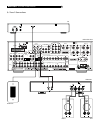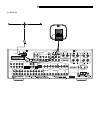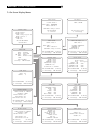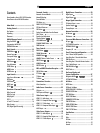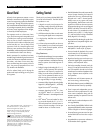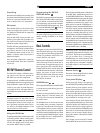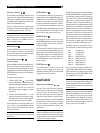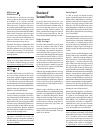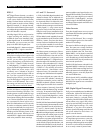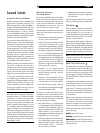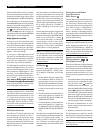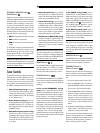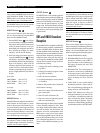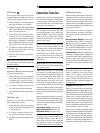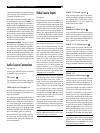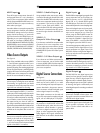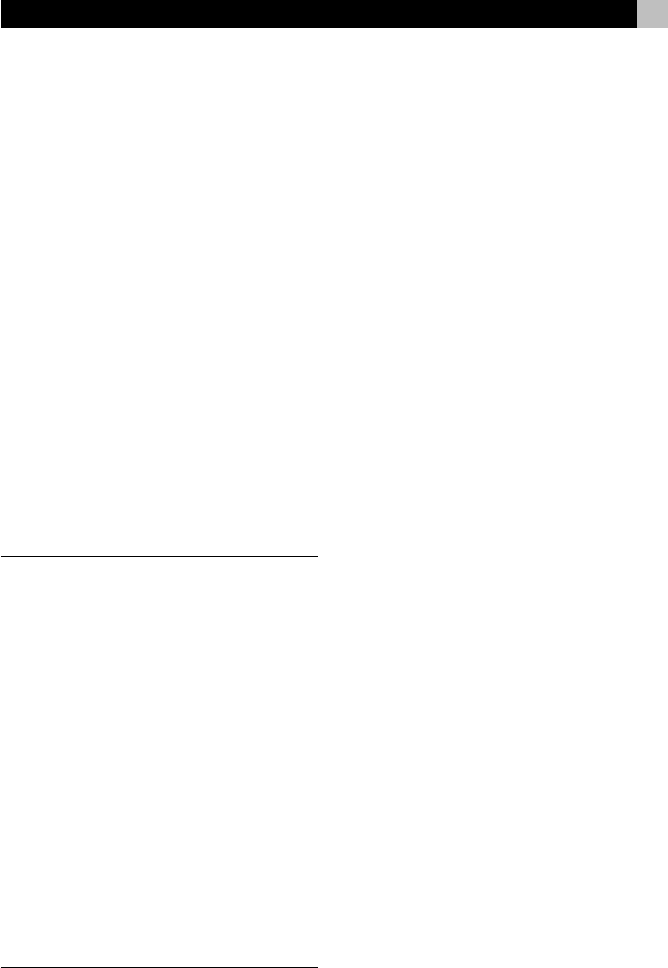
16
RSX-1055 Surround Sound Receiver
DTS
5.1
DTS
®
(Digital Theater Systems) is an alterna-
tive digital format competing with Dolby Digital
in both movie theaters and home theater
markets. The basic features and functions of
the DTS system are similar to those of Dolby
Digital (for example, 5.1 discrete channels),
however the technical details of the compres-
sion and decoding processes differ somewhat
and a DTS decoder is required.
Like Dolby Digital, DTS can only be used on
a digital recording and, therefore, is only
available for home use on LaserDiscs, DVDs,
or other digital formats. To use the RSX-1055’s
DTS decoder, you must connect your DVD
player to the RSX-1055’s digital inputs.
As with Dolby Digital 5.1, detection and proper
decoding of DTS 5.1 signals is automatic.
NOTE
: DVDs with a DTS soundtrack almost
always have it configured as an option to the
standard matrix Dolby Surround format. To
use DTS, you may have to go to the setup
menus at the beginning of the DVD and se-
lect “DTS 5.1” instead of “Dolby Surround”
or “Dolby Digital 5.1”. In addition, many DVD
players have the DTS digital bitstream turned
off by default and cannot output a DTS
soundtrack, even if selected on the disc’s
menu, until you activate the player’s DTS out-
put. If you hear no sound the first time you
attempt to play a DTS disc, you may have to
go to the DVD player’s configuration menus
and turn on the DTS bitstream. This is a one-
time setting and need only be done once.
See your DVD owners manual for details.
The RSX-1055 features a second type of DTS
surround sound decoding: DTS Neo:6. This
decoding system is similar to Dolby Pro Logic
II in that it is designed for playback of any 2-
channel stereo recording, either matrix-encoded
or not. The Neo:6 decoder can by used with
any conventional 2-channel source such a
stereo TV or FM broadcast or a CD. It can also
be used as an alternative method of decod-
ing matrix-encoded Dolby Surround record-
ings or TV broadcasts. Activate the DTS Neo:6
decoding with the DTS:Neo 6 button as de-
tailed later in this section. DTS Neo:6 is not
used with DTS 5.1 digital sources and the button
need not be pressed for those recordings.
6.1 and 7.1 Surround
In 1999, the first Dolby Digital soundtrack was
released to theaters with an additional cen-
ter back surround channel, intended to increase
the directional effects from behind the audi-
ence. This additional surround channel is en-
coded into the two existing surround channels
in Dolby Digital 5.1, using a matrix encod-
ing process similar to that used previously in
Dolby Surround. This new extended surround
capability is called Dolby Digital Surround EX.
DTS has added a similar capability for record-
ing this extended surround information called
DTS-ES
®
6.1 Matrix. They have also taken it
one step further and developed the capabil-
ity to record this extended surround informa-
tion as a fully discrete channel in a system called
DTS-ES
®
6.1 Discrete.
All of these systems are extensions of the ex-
isting Dolby Digital 5.1 and DTS 5.1 digital
surround sound formats. Users with one cen-
ter back speaker (a 6.1 configuration) or two
center back speakers (a 7.1 configuration) can
take advantage of this extended surround in-
formation. Users with traditional 5.1 channel
systems can play Dolby Digital Surround EX
or DTS-ES 6.1 discs and they will sound ex-
actly the same as 5.1 channel discs in each
respective format. The extended surround
recordings are 100% backwards compatible.
If you have configured your system with one
or two center back speakers, decoding of
DTS-ES discs is automatic, just as it is with stan-
dard DTS soundtracks. Likewise, decoding of
Dolby Digital Surround EX discs is automatic
with one exception. Some early Surround EX
titles did not have the detection “flag” encoded
on the disc. To activate the Dolby Digital Sur-
round EX features for these discs or for stan-
dard 5.1 channel Dolby Digital discs, use the
Dolby PLII/3ST button described in the next
section of this manual.
The RSX-1055 also features Rotel XS (eXtended
Surround) processing that automatically ensures
optimum extended surround performance on
6.1 and 7.1 channel systems. The key ben-
efit of Rotel XS is that it works at all times with
all multichannel digital signals, even those that
might not otherwise activate proper surround
decoding for the center back channel(s). Al-
ways active in any system configured with cen-
ter back speaker(s), Rotel XS monitors the sur-
round channels, properly decodes them, and
distributes the extended surround channels to
the center back speaker(s). Rotel XS works with
matrix-encoded surround signals (such as non-
flagged DTS-ES and Dolby Surround EX discs)
as well as non-matrix digital source material
(such as DTS 5.1, Dolby Digital 5.1, and even
Dolby Pro Logic II decoded Dolby Digital 2.0
recordings) to derive superb center back chan-
nel surround effects.
Other Formats
Three other digital formats are not surround
sound formats at all, but rather systems for digital
2-channel recordings.
The first is PCM 2-channel. This is a straight
2-channel digital signal such as that used for
standard CD recordings.
The second is HDCD
®
encoding for compact
discs. This system uses a variety of enhance-
ments to improve the sonic performance com-
pared to standard audio CDs. These discs,
labeled HDCD, can be played on standard
CD players. However, when the digital sig-
nal is decoded using an HDCD decoder like
that in the RSX-1055, they will provide excep-
tional musical reproduction.
The RSX-1055 also features a decoder for the
digital MP3 (MPEG1- Audio Layer 3) compres-
sion format. MP3 format recordings are avail-
able on the Internet and can be played on por-
table MP3 players or some disc players that
can read CD-ROM discs.
PCM 2-channel, HDCD, and MP3 are digital
formats. They can only be decoded by the
RSX-1055 from digital sources connected to
the digital inputs.
DSP (Digital Signal Processing)
Finally, one more related issue to be addressed
is DSP modes. Unlike all of the formats men-
tioned above, DSP is not a recording/play-
back system. Instead, it is a digital process-
ing feature of the RSX-1055 that adds special
acoustic effects to any signal. DSP process-
ing can be used with Dolby Surround record-
ings, Dolby Digital recordings, CDs, radio
broadcasts, or any other source material;
however, typically DSP settings would be used
with source material for which there is no
specific surround decoder.
In general, DSP is used to create the ambience
of a large listening environment: a jazz club,
a concert hall, a stadium, etc. It uses digital
processing to delay the signal to various speak-
ers and mix in various levels of reverberation.
Its use is strictly a matter of personal taste.



